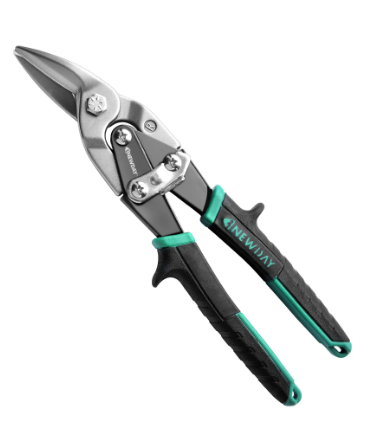Precision and Maneuverability in Metal Cutting
Curved and Straight Cutting Capabilities
Aviation snips cut both curves and straight lines without breaking a sweat something regular snips just cant handle when working on complex shapes. The special blade design lets workers make really accurate cuts which matters a lot in things like HVAC systems or ductwork installations where everything needs to fit together tightly and look neat. Some studies show these specialty cutters can actually speed up work by around 30 percent, which explains why so many metalworkers rely on them whenever they need to do precise cutting jobs. For anyone dealing with all sorts of different cuts day after day, aviation snips simply become part of the toolkit.
Reduced Hand Fatigue with Compound Leverage
Aviation snips have this great feature called compound leverage that makes cutting so much easier on the hands. The mechanism actually cuts down how hard someone needs to squeeze, which means workers can keep going longer without getting tired out. Metalworkers who've switched to these snips frequently mention feeling less soreness in their hands after a day's work because of the way they're designed. And this isn't just about comfort either. Less hand strain translates to better productivity while also cutting down chances of those nasty repetitive strain injuries everyone worries about in metal shops. Some studies show folks experience around 40% less fatigue switching from old school tin snips to aviation models. Makes sense really why so many professionals now reach for aviation snips first thing in the morning when tackling tough metal jobs.
Versatility Across Metalworking Industries
HVAC and Ductwork Fabrication
Aviation snips are pretty much essential tools for anyone working on HVAC systems or making ductwork these days. These snips handle all sorts of metals at different thickness levels and make precise cuts every time. When technicians get clean cuts right from the start, there's just not as much need to go back and fix things later, so everything fits together better when installing duct systems. According to some field data we've seen, shops that regularly use aviation snips report cutting down fabrication time around 20% on average for typical HVAC jobs. That kind of time savings really adds up over multiple projects across an entire season.
Automotive Repairs and Customizations
Clean lines and precise cuts matter a lot in car manufacturing if we want both good looks and proper function. That's where aviation snips come into play. These tools let mechanics make those exact cuts needed for things like exhaust systems, panel replacements, and trim adjustments around vehicles. Most techs will tell anyone who asks about how much easier these snips make working in cramped areas. They just move better than regular tin snips when getting into those awkward spots between components. Shops that have switched to aviation snips report noticeably better finishes on their projects. Mechanics actually see fewer mistakes and cleaner seams overall after making the switch, according to what many auto shops are saying these days.
Artistic Metal Sculptures and Decor
Many artists and sculptors grab aviation snips whenever they need to craft those really detailed metal sculptures. What makes these tools so special? They let creators bend and cut different types of sheet metal without breaking a sweat, which is why folks in the design world love them for everything from massive public art installations down to tiny decorative accents on furniture. According to some industry surveys, around seven out of ten artists actually say they're happier with how precise their work looks after switching to aviation snips. Most will tell anyone who asks that those razor sharp cuts make all the difference in achieving the kind of fine details that really bring metal artwork to life.
Ergonomic Design Enhancements
Offset Handles for Improved Safety
The offset handle design on aviation snips really boosts safety because it gives workers a much better grip while cutting through materials. When someone holds these snips properly, they can apply more pressure without putting so much strain on their wrists. This means less tired hands after a long day at work and fewer chances of getting those annoying repetitive strain injuries that nobody wants. According to some industry reports, people who switch to ergonomically designed tools actually see around 30 percent fewer injuries related to their hands and wrists. That's pretty significant considering how often metalworkers need to cut things throughout their shifts. For anyone spending hours in workshops or fabrication shops, having this kind of grip advantage makes all the difference between finishing a job safely and ending up sidelined with an injury.
Color-Coded Handles for Easy Identification
The colored handles on aviation snips make it much easier to spot the right tool fast, which matters a lot when working in busy environments where every second counts. When tools are organized this way, people don't waste time digging through boxes looking for what they need. Some research shows that being able to quickly find tools cuts down search time around 25% in many shops. For mechanics and technicians dealing with tight deadlines, having color coded aviation snips means less frustration during projects. Most experienced tradespeople will tell anyone who'll listen how much difference good organization makes at the end of a long day.
Aviation Snips vs. Traditional Tin Snips
Cutting Mechanism and Leverage Differences
Aviation snips work differently from regular tin snips because they incorporate a compound lever system that gives users much better leverage. The way these tools are designed actually boosts their cutting power significantly, which means they handle tough jobs much better than standard snips ever could. According to industry experts, this mechanical advantage can boost cutting force by around half, so workers find themselves able to slice through harder metals and intricate shapes without breaking a sweat. For anyone who needs both accuracy and muscle in their tool kit, aviation snips simply beat out traditional options when working on challenging metal projects like sheet metal fabrication or automotive repairs where consistent cuts matter most.
Material Thickness and Application Suitability
Aviation snips were designed to tackle all sorts of metal thicknesses, which makes them much more versatile than regular tin snips when working across different industries. These specialized cutting tools can slice through various metals including aluminum, stainless steel, and even copper sheets, something that opens up plenty of possibilities for shops doing detailed metal fabrication work. Tests run by manufacturers indicate that aviation snips can manage up to 18-gauge material while standard tin snips struggle beyond 22-gauge. The real advantage here is that professionals don't need multiple sets of snips for different jobs anymore. Most workshops find these tools meet standard requirements out of the box, so they become go-to equipment for anyone serious about metalworking projects.
Long-Term Durability and Cost Efficiency
Proper Maintenance Techniques
Keeping aviation snips in good condition matters a lot if we want them to last and work properly. Cleaning them regularly and applying some lubricant goes a long way toward making these tools last longer. When dirt and rust start building up, it really affects how well they cut through materials. The truth is, taking care of these cutting tools does two main things: first, it keeps them performing at their best, and second, it actually makes working with them safer since worn out parts are less likely to fail unexpectedly during use. According to what many professionals say, tools that get proper attention tend to stay useful about three times as long compared to ones neglected over time. So spending even just a few minutes on maintenance isn't just about keeping our equipment sharp it turns out to be pretty smart financially speaking when looking at replacement costs down the road.
Choosing the Right Snip for the Job
Getting the right aviation snip for the job makes all the difference when it comes to working faster and making cleaner cuts. There are basically three main types out there right now: right cut, left cut, and straight cut models. Each one handles different materials and angles better than others. When someone knows what each snip does best, they end up wasting less time and material on mistakes. Some field tests actually found workers got about 40% more done per day just by grabbing the proper snip first thing. So while it might seem like extra effort upfront, spending a few minutes picking the right tool pays off big time in both speed and quality of work.
FAQ
What are aviation snips used for?
Aviation snips are used for cutting various types and thicknesses of metal with precision, including curved and straight cuts.
How do aviation snips reduce hand fatigue?
The compound leverage mechanism in aviation snips significantly reduces the hand force required, minimizing hand fatigue during extended use.
Why are color-coded handles important on aviation snips?
Color-coded handles allow for quick tool identification, increasing efficiency and organization in busy work environments.
Can aviation snips cut thicker metal than traditional tin snips?
Yes, aviation snips can handle up to 18-gauge metal, compared to traditional tin snips which are generally limited to 22-gauge.
What maintenance do aviation snips require?
Regular cleaning and lubrication are necessary to maintain optimal performance and extend the tool's lifespan, preventing rust and debris buildup.


